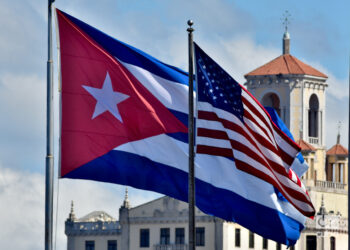First the Spanish oil company Repsol found a dry well. Now Cubapetroleo (CUPET) just announced that Scarabeo 9, the drill rig used by Gazpromneft (Russia) and PC Gulf (Malaysia) found what they were looking for, but not in significant quantities and conditions that could be considered a commercial discovery.
It was a second fruitless attempt that though doesn’t come as a surprise does cast a shadow over the expectations, although the results are consistent with the average in the industry, with one positive well out of every five or six of which are drilled. The truth is that the hopes placed in the oil of Cuba’s Exclusive Economic Zone (EEZ) in the Gulf of Mexico invite to wonder if finally the third time is a charm, now that the baton is passed to PDVSA; a company that will start drilling these days the Cape of San Antonio 1 well.
Despite searching by land, water and air, Scarabeo 9 hasn’t been able to find what it is looking for. It will give it a new try in one of the 22 leased blocks, this time one leased by Petroleos de Venezuela (PDVSA), which will drill a square across from the western tip of the country, some 100 kilometers from Cancun.
PDVSA executives noted that geological studies indicate that the lots leased by the Venezuelan company are “very promising”. Whether Cuba wins the oil lottery remains to be seen, precisely because the road ahead for the Scarabeo 9 does not seem to be an easy one, just like the one it has gone through.
Because there are many things are at stake for Cuba in finding this so-much-longed-for oil. First, an economic boom that Cuba hasn’t seen since the days when the world’s craving for sugar depended on Cuba. Something based on two pillars. First, because, it could use oil reserves to secure new financing, in fact, some sources indicate that China and Brazil are seen as potential lenders, and second this "finding" could improve relations with the United States, as the powerful oil lobby could push the US Congress to participate in this business with Cuba, which is safer and closer, which would also ensure that country the oil it consumes and also reduce transportation costs.
For now, the two countries, along with Mexico and the Bahamas are signatories to the regulatory framework of the EEZ and American specialists certified the platform in Trinidad and Tobago, before his arrival in Cuba, in agreement with Repsol. They have even made coordinations, but still have the challenge of promoting contingency plans to prevent any spill that could smear the beaches of the two countries, an outstanding debt on the north side.
Of course, for Cuba to start its work on the part of the EEZ that belongs to it has become difficult, since there were quite a few pressures. In fact, to do so, an Italian-owned semi-submersible platform: the Scarabeo 9, only one of its kind in the world to comply with the US “requirement” of being made with less than 10 percent of U.S. components was built in China and Singapore.
Otherwise, the companies that use it would be subject to economic reprisals because of the US blockade against the island. In fact, this platform has been praised as one of the best of its kind, its safety surpassing even those used in the EEZ blocks belonging to Mexico and the US.
But building a “tailored” platform for Cuba raises another problem which is that the lease is 511 000 dollars a day, well above the average worldwide, which increases enormously the investment. To Repsol alone the cost was nearly a million dollars per day.
Although that is not the only bad news for Cuba: Scarabeo-9 only drill two or three more wells in the Cuban area until 2013, before traveling to Brazil, and there is still no date for its return to Cuba.
"If they don’t find oil now, I think it will take another five to ten years before anyone else comes to drill again," said Jorge Pinon, former president of Amoco Oil Latin America and an expert on Cuban energy prospects. "It’s not because there is no oil, but because the hurdles to overcome for drilling in Cuba make it unworthy when there are better options and easier in places like Angola, Brazil and the U.S. Gulf of Mexico."
The fact that there is oil in the 112,000 square kilometers of EEZ is something nobody doubts; Cuban experts estimate that the reserves in the area of the island are 20 000 billion barrels, while the U.S. Geological Survey estimated the figure at about 5 000 billion. Anywhere in the neighborhood will be enough for Cuba.
Scarabeo is not alone
Although almost all hopes about oil are based in the EEZ of the Gulf, these are not the only wells drilled for oil since Cuba pumps crude in the north-west part of the island, to which is added now what the Russian state company Zarubezhneft will do, which plans to begin exploring in late November in Cuban waters.
For this purpose it will use another semi-submersible platform in Block L of the Cuban economic borders with Bahamas, which is located on the north of the center-western provinces of the island. According to Ria Novosti, the Russian oil company has the right to participate in the exploration and extraction of oil in four blocks, two of which are at sea, on two on land. This platform is much less powerful because it can drill in water depths up to 1 200 feet, while the Scarabeo 9, which is looking for oil in Cuban waters, can drill in water depths up to 12 000 feet.









